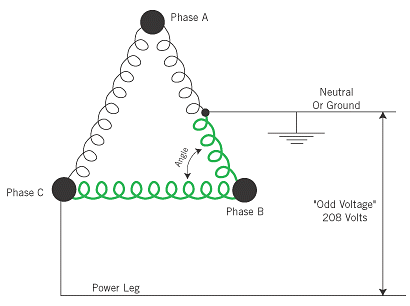This article will try and explain the voltages associated with the high or wild leg coming from the secondary of a Delta service transformer. The wild or high leg of a service transformer is only associated with the Delta transformer. (For the remainder of this article, the term “power leg” will be used in place of high leg or wild leg.)
Many commercial-industrial buildings have their electric power delivered by means of dual-voltage, 60-Hz service that may be described as a 120/240-V, three-phase, four-wire Delta drop. The secondary of the Delta transformer, which delivers power to a building, is shown in Figure 1.

Remember, the secondary of these transformers receives its voltage from the primary windings of the transformer through induced voltage. The primary windings are not shown.
Any time a Delta transformer’s secondary winding is center tapped, a power leg is created. Notice that in Figure 1, one of the windings of the Delta transformer has been center tapped and then connected to earth ground. This center tap is grounded to a ground rod driven into the earth, which grounds the neutral wire and the equipment’s chassis.
Figure 1 also shows the single-phase voltages that can be picked off the secondary of the Delta transformer. Listed here are those single-phase voltages:
A to B — 240 V;
A to C — 240 V;
B to C — 240 V.
If all three phases or legs (A, B, and C) of the Delta transformer were used, 240-V/three-phase power can be used:
A to N — 120 V;
B to N — 120 V.
Notice that when the winding of the transformer was center tapped to ground, it divided the total winding voltage (240 V) into two 120-V windings connected in series (Figure 1). This happened because the winding was divided perfectly in half. Both phase A and phase B relative to the center tap or ground would be 120 V, and could be used for any single-phase, 120-V sources.
The Odd Voltage
What isn’t shown in Figure 1 is what the voltage would be from phase C to leg N. This would be the power leg to ground. Notice that the power leg referenced to the center tap or ground would consist of one entire winding and half of another winding with an angle in the middle (Figure 2).
The voltage between phase C and N is neither 240 nor 120 V. It is an odd voltage that usually falls around 208 to 210 V, single phase. (This 208 V should not be confused with the 208 V coming from a wye transfer’s secondary, which will be covered in a future column.)
The actual voltage of this odd voltage will vary depending on the turns ratio of the primary and secondary windings. This is why phase C is referred to as the power leg. The power leg is an unusually colored orange, so it can be readily recognized.
Never wire the power leg to a 120-V source! It should only be used on 240-V, three-phase loads or 240-V, single-phase loads. If it is hooked to a 120-V, single-phase load, the load will eventually fail from too high of a voltage source.
Notice that the power leg only has this odd voltage when it is referenced to ground. Again, this is because it is working through an entire winding and another half winding with an angle in between. This does not hold true for phase B and phase A referenced to ground. They simply split the one winding between phase A and B in half.
Tomczyk is a professor of HVAC at Ferris State University, Big Rapids, Mich., and the author of Troubleshooting and Servicing Modern Air Conditioning & Refrigeration Systems, published by ESCO Press (800-726-9696). Tomczyk can be reached at tomczykj@tucker-usa.com.
Publication date: 03/03/2003





